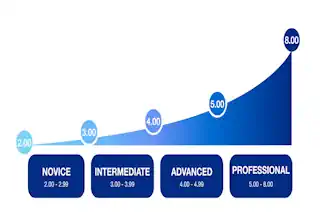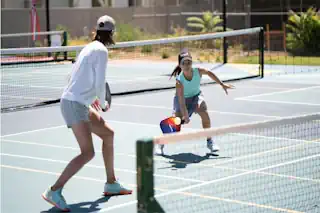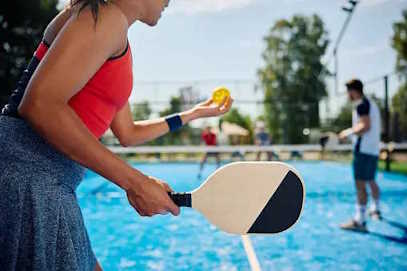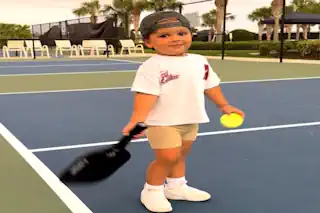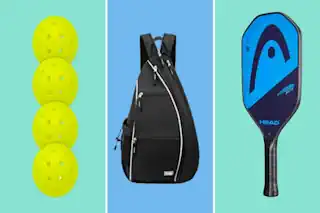Mastering the Court: Essential Pickleball Drills for Defenders

Hey there, fellow pickleball enthusiasts! Whether you’re just starting to dip your toes in the game or you’ve been hitting the courts for a while, there’s always room to level up your defensive game. Today, we’re focusing on the defenders among us—the unsung heroes of pickleball who can turn the tide of any game with their skill and strategy.
Introduction to Pickleball Defense and the Importance of Drills for Defenders
Pickleball, a sport that combines elements of tennis, badminton, and ping-pong, has taken the world by storm. It’s not just about having a fast serve or a powerful smash; being a great defender can make you a formidable player winning pickleball matches on any court. That’s where drills come into play. They help improve your footwork, positioning, reflexes, and overall strategy, making you an invaluable member of any pickleball team.
Let’s Start with the Basic Rules of Pickleball
The Rules Reminder
Before we get into the swing of things, it’s important to know the fundamental rules of pickleball play. Players use solid paddles made of wood or composite materials to hit a perforated polymer ball, similar to a Wiffle Ball, over a net. The net is lower than in tennis but not as low as in badminton. The game can be played either with two players (singles) or four players (doubles).
Here’s a quick rundown of the basic pickleball rules to get you started. Think of it as your quick-start guide to fun pickleball matches:
Serve it right: Serve must be underhand with the paddle below the waist, and the ball must be hit in the air without bouncing. The serve is made diagonally across the court to the opponent’s opposite corner or opposite side of the court.
Service errors: Errors during service, such as serving out of turn, serving the ball into the net, or serving the ball out of bounds, lead to faults. Keeping a keen eye on your serve’s direction and height can help avoid these mistakes.
Double-bounce rule: After the ball is served, the receiving team must let it bounce once before returning, and then the serving team must also let the returned ball bounce once before playing it. After these two bounces, players may either volley the ball in the air or play it off a bounce.
No-volley zone: The court has a 7-foot zone on either side of the net, known as the “kitchen,” where players cannot volley the ball. Players must observe this rule to avoid faults.
Scoring: Points can only be scored by the serving team when the opponent fails to return the ball or commits a fault. The game is played to 11 points, and a team must win by at least 2 points.
Switching sides: Each team switches sides after the first game. In a tiebreaker (the third game of a match), teams switch sides when one team reaches 6 points.
Stepping into the kitchen on a volley: One of the most common faults in pickleball occurs when a player steps into the no-volley zone, or the kitchen, to hit a volley shot. Remember, you can step into the kitchen to hit the ball if it bounces first, but volleying from within this zone is a definite no-go.
Hitting the ball out of bounds: Just like in tennis or badminton, if the ball lands outside the designated play area, it’s considered out, and the point goes to the other team. Judging the ball’s trajectory and controlling your shot power are key skills to keep the ball in play.
Remember, pickleball is as much about having fun and making friends as it is about following these rules.
Understanding the Defender’s Pickleball Drill
Unlike most drills and other pickleball drills that focus on general play, the Defender’s Pickleball Drill is purpose-built for defending from shot-makers. It emphasizes anticipating shot placement, predicting ball speed, and the development of soft hands to control ball placement. This drill is perfect for those who want to be able to defend shots with surgical precision, regardless of pressure.
Drill Set-Up and Equipment Needed
To execute the Defender’s Drill, you need a pickleball court, a partner, and, of course, your trusty paddles and pickleballs. Mark a 4-foot deep rectangle or set up your chosen target, on the opponent’s side of the court to create a target for your opponent to defend. This is now the target you are shooting for and the target they are defending. Your opponent will also place a target which they will shoot at and you must defend.
Technique and Execution
The key to the Defender’s Drill lies in sequential progress. Your aim is to prevent your opponent from hitting their target while you try to successfully hit yours. Target placement can be done in multiple areas to work on various shots. Make sure you are in your ready position and then with good footwork move into a good position. This will also help improve reaction time and anticipation.
Step-by-Step Guide
To ensure that each shot you defend is a deliberate step toward your goal, follow these steps closely:
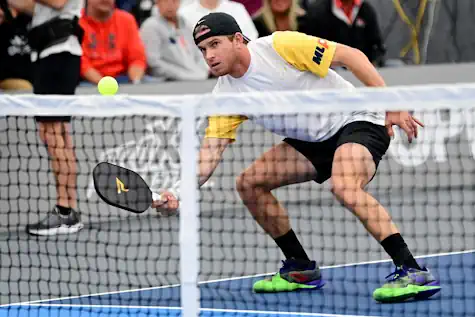
Step One: Mastering the Dink
Start the drill by working on your dinks. These are light, controlled shots intended to just pass the net and land softly on your opponent’s side. Instead of just aiming at your target, try to dink in areas to lure your opponent away from your target so you can hit the target with you next shot. Try to dink from different angles inside and just outside of the non volley zone.
Step Two: Progressing to the Drive
Move on to drive shots, which means the target is now anywhere on the rest of the court. Again, we need to defend the target on our side while we try to hit the target on the opponent’s side. Work forehand shots and backhand shots equally. Aim is important, especially as you back away from the net.
Step Three: Third Shot Drop
The third shot drop is the opportunity for the serving team to win the point or in this case strike the target with the third shot. Shot drops and drop drills often focus on the third shot drop as it is the first chance after the serve for the serving team to win the point during game play. Practice dropping the ball into strategically difficult places for the other team to return. This might mean a lob shot to the back of the court if they have advanced or a drop shot into the kitchen line. We need to get an open shot at our target which might mean several shots placed to lure the defender away.
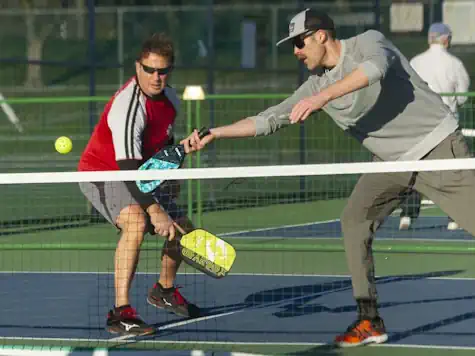
Step Four: The Lob and Volley
The lob comes next, a high arching shot used on offense to push opponents back. Well placed lob shots will draw the opponent deep into the back of the court and open up your target for attack.
Volley shots are exchanges at the net, and your goal here is to watch and learn to direct your volleys with purpose into the shooting zone while drawing your opponent away from a defensive position.
Step Five: Simulated Match Conditions
Simulate match situations with your partner, alternating shots and trying to maintain a rally with accuracy. Gradually increase the pace and power of your shots, always aiming to hit more points and targets within your shooting zone. Consider focusing on a third shot drop or third shot drive. Remember as much as we are trying to hit our target it is even more important that we defend the target on our side.
Defenders Team Play
After working the static shot drop drill with your partner it is now time to turn this into an exciting game to see how well you can place the shot during live situations and defend your side of the court. For live game play, each team will need a target of equal size. Targets could be things like ball cans, cones, t-shirts, towels, pop cans, etc. The targets need to be something that will be obviously noticed when hit. As players improve the targets can get smaller and placed in more difficult locations.
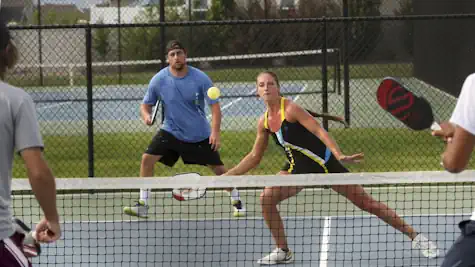
Before we start the game, each team will need to place their target. Targets need to be placed in hittable locations.
We start with a standard serve. The ball hit below the waist and cross-court.
Next is the double bounce rule. The receiving team must let the ball bounce before hitting it back and the serving team must let the ball bounce before hitting it back
Now we start Defenders
The objective is to hit the target or push your opponent to a position that will force them to return the ball to you in such a manner it will make your potential for hitting their target much higher.
If you are the player defending your target your goal is to use your defensive shot in such a way that it creates an offensive opportunity.
The first team to hit the other team’s target scores an immediate 7 points and gets the serve. Otherwise, each point is earned just as during standard game play.
Play continues to a score of 11.
After a target is hit, each team must place their target in a new location.
The same rules apply during singles play just be sure to use a target that will not cause tripping if you lose track of the target during play.
Common Mistakes and How to Fix Them
The most common mistake pickleball players make with the Defender’s Drill is rushing their shots, leading to poor accuracy. Always take your time to set up your shot correctly. Additionally, ensure that you are not overcompensating on your shots by flicking your wrist too much, causing the ball to sail wide. Focus on a smooth follow-through motion for each shot.
Refine Your Execution
To get the most out of this drill, definitely practice hitting it with a range of partners. Each one will challenge you in different ways, helping you to become more adaptable to the variety that occurs in a match. This drill can be executed as one player as long as a pickleball machine is available to replace the other player.
Assess and Adjust
Stop periodically to assess your results. Are you getting more balls in the zone? Are they landing where you intended? Use these moments to adjust your technique and keep refining your shots.
Incorporate Goals into Practice
Set personal benchmarks for your practice sessions. Whether it’s a certain percentage of balls in the zone or a specific number of consecutive shots, having a goal will keep you motivated and focused.
Maintain a Positive Mindset
Remember that improvement in pickleball is a marathon, not a sprint. Celebrate every success and use every miss as a learning opportunity. A positive, growth-oriented mindset will keep you primed for progress.
Conclusion: Encouragement to Continue
Remember, every player’s journey is unique, and progress comes at different paces for everyone. The key is to stay persistent, practice regularly, and never lose the joy of playing your best pickleball ever. Whether you’re aiming to compete at higher levels or just enjoy the game with friends, improving your defensive skills will undoubtedly make you a more complete player.
Now, grab your paddle and hit the court with confidence. The best defense is a good… well, defense! Happy playing, and here’s to many more games where you dazzle as a defender.
FAQ
How often should I practice the Defender’s Drill?
Aim to practice the Defender’s Drill at least two to three times a week. Consistent practice will help you refine your technique and improve your accuracy in live match situations.
What should I do if I don’t have a partner to practice with?
If you don’t have a partner, you can use a pickleball machine to simulate the shots and practice your defenses. This allows you to still work on your accuracy and placement without needing another player.
How can I avoid rushing my shots during the drill?
To avoid rushing your shots, focus on your setup before hitting the ball. Take a deep breath, ensure your stance is correct, and aim for a smooth follow-through. Practice maintaining a calm and steady pace, even under pressure.
What should I do if my shots keep sailing wide?
If your shots are going wide, it might be due to overcompensation or excessive wrist action. Focus on a smooth, controlled follow-through and ensure you’re aiming correctly. Adjust your grip if needed to maintain better control over the ball.
How can I make the targets more challenging over time?
As you improve, make your targets smaller and place them in more difficult locations around the court. This will test your precision and help you become more adept at defending soft shots and hitting challenging shots.
What mental approach should I have when practicing?
Maintain a positive and growth-oriented mindset. Celebrate small successes and view each mistake as a learning opportunity. Stay patient with your progress and enjoy the process of improving your skills.
Is it normal for progress to be slow at first?
Absolutely. Improvement in pickleball, like any sport, takes time and persistence. Keep practicing regularly, and you’ll likely see gradual progress. Embrace the journey and enjoy each step of becoming a better player.
Can I incorporate this drill into a warm-up routine?
Yes, the Defender’s Drill can be an excellent addition to your warm-up routine, helping you focus on placement and accuracy right from the start. It gets you in the right body and mindset for match play and helps you build good habits.
How do I keep track of my progress?
Set specific goals for your practice sessions and keep a record of your achievements. Whether it’s hitting a certain percentage of targets or maintaining a rally for longer periods, tracking your progress will help you stay motivated and see your development over time.
